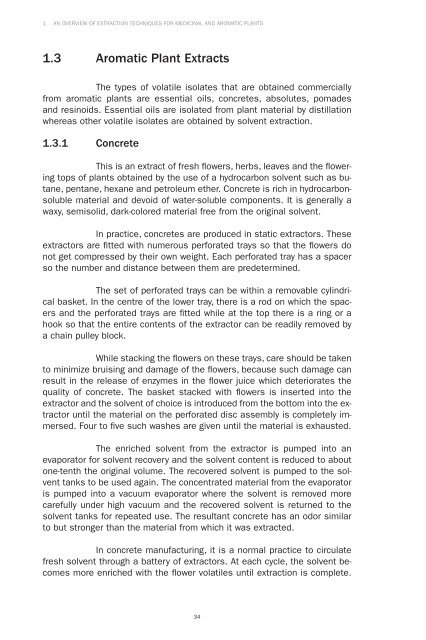Extraction Technologies For Medicinal And Aromatic Plants - Unido
Extraction Technologies For Medicinal And Aromatic Plants - Unido
Extraction Technologies For Medicinal And Aromatic Plants - Unido
You also want an ePaper? Increase the reach of your titles
YUMPU automatically turns print PDFs into web optimized ePapers that Google loves.
1 AN OVERVIEW OF EXTRACTION TECHNIQUES FOR MEDICINAL AND AROMATIC PLANTS<br />
1.3 <strong>Aromatic</strong> Plant Extracts<br />
The types of volatile isolates that are obtained commercially<br />
from aromatic plants are essential oils, concretes, absolutes, pomades<br />
and resinoids. Essential oils are isolated from plant material by distillation<br />
whereas other volatile isolates are obtained by solvent extraction.<br />
1.3.1 Concrete<br />
This is an extract of fresh fl owers, herbs, leaves and the fl owering<br />
tops of plants obtained by the use of a hydrocarbon solvent such as butane,<br />
pentane, hexane and petroleum ether. Concrete is rich in hydrocarbonsoluble<br />
material and devoid of water-soluble components. It is generally a<br />
waxy, semisolid, dark-colored material free from the original solvent.<br />
In practice, concretes are produced in static extractors. These<br />
extractors are fi tted with numerous perforated trays so that the fl owers do<br />
not get compressed by their own weight. Each perforated tray has a spacer<br />
so the number and distance between them are predetermined.<br />
The set of perforated trays can be within a removable cylindrical<br />
basket. In the centre of the lower tray, there is a rod on which the spacers<br />
and the perforated trays are fi tted while at the top there is a ring or a<br />
hook so that the entire contents of the extractor can be readily removed by<br />
a chain pulley block.<br />
While stacking the fl owers on these trays, care should be taken<br />
to minimize bruising and damage of the fl owers, because such damage can<br />
result in the release of enzymes in the fl ower juice which deteriorates the<br />
quality of concrete. The basket stacked with fl owers is inserted into the<br />
extractor and the solvent of choice is introduced from the bottom into the extractor<br />
until the material on the perforated disc assembly is completely immersed.<br />
Four to fi ve such washes are given until the material is exhausted.<br />
The enriched solvent from the extractor is pumped into an<br />
evaporator for solvent recovery and the solvent content is reduced to about<br />
one-tenth the original volume. The recovered solvent is pumped to the solvent<br />
tanks to be used again. The concentrated material from the evaporator<br />
is pumped into a vacuum evaporator where the solvent is removed more<br />
carefully under high vacuum and the recovered solvent is returned to the<br />
solvent tanks for repeated use. The resultant concrete has an odor similar<br />
to but stronger than the material from which it was extracted.<br />
In concrete manufacturing, it is a normal practice to circulate<br />
fresh solvent through a battery of extractors. At each cycle, the solvent becomes<br />
more enriched with the fl ower volatiles until extraction is complete.<br />
34

















